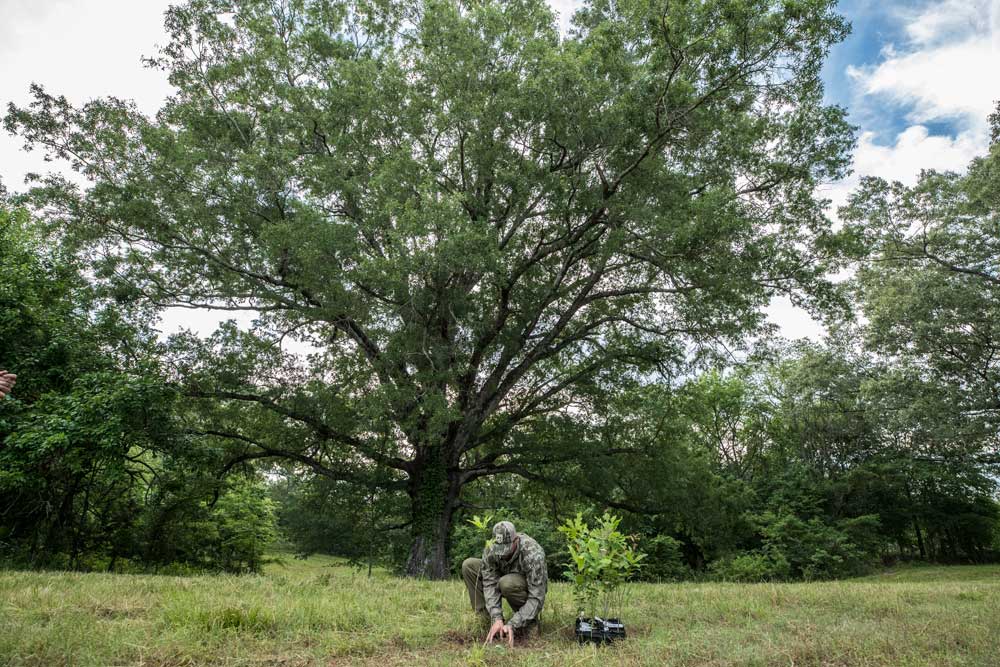The oak tree is essential to wildlife, and Gamekeepers and hunters alike know the value in a producing oak tree. Acorns provide the protein, carbohydrates and fats animals need to survive the winter. Let’s look at identifying acorns, what acorns are most desirable and when acorns are available.
NOT ALL ACORNS ARE CREATED EQUAL
If you have been backcountry camping, you have probably used oak for your firewood. You may not need to know the particular species of the oak tree you used to fry bacon in the morning, but deer hunters need to know their oak trees. There are two families of oak trees in the United States – the red oak and the white oak. All of our native oak tree species belong to one of these two families.

The quickest way to tell if an oak tree is from the red oak or white oak family is to examine its leaves. The red oak leaf has a bristle-tipped lobe. The bristle or small barb on the tip of the leaf lets you know you’re dealing with a tree from the red oak family. The white oak leaf does not have a barb, and the tips of the leaf are either rounded or saw-toothed. Another giveaway is the acorn. The top cap of the red oak acorn is scaly, while the white oak acorn has a knobby top cap.
Your dad may have passed down hunting tips like how to tell a red oak from a white oak. He probably mentioned the bark of a red oak tree is smoother and harder than that of a white oak tree. Most white oak bark is softer and tends to be flaky compared to most red oak trees. White oak bark tends to have deep ridges and has a rough look compared to most red oak. The white oak barks are typically ash-gray colored. Red oak trees have a dark brown bark with brownish ridges on most species.
THE INCREDIBLE EDIBLE ACORN
You may come from an area of the nation that calls them “acorns” or an area that calls them “acerns.” Either way, deer prefer white oak acorns to that of red oak. The red oak acorn has more tannin or tannic acid than the white oak. Tannin is nature’s preservative, so red oak acorns last longer on the ground. Tannin is bitter to the taste, so deer prefer the much sweeter white oak acorn.

In areas where both the red and white oak grows, deer will walk past red oak acorns to get to the white oak. These deer hunting tips are vital to know when scouting an area. Even deer hunters who spend a lot of time and money on food plots, are perplexed when deer disappear in the fall. Hunters with oak trees in their deer woods should plan for the acorn drop. Deer won’t come out in the open when they can stay back in the woods and eat acorns.
TIMING IS EVERYTHING
White oak trees typically drop their acorns before red oak trees. Generally, this is in September and early October. If your deer season opens in September, you should set up near white oak trees as deer love white oak acorns. The white oak acorns don’t last long as deer and hogs vacuum them up as soon as they fall. Any white oak acorn that survives the feast soon rots or sprouts as it does not have the tannin needed to preserve it.

Red oaks, or rut oaks as some deer hunters call them, are often a food source during the rut. After the acorn has been exposed to the elements, the tannin will leach from the acorn. By the time the rut rolls around, it is more palatable to deer. With that said, don’t be surprised if you see deer eating freshly dropped red oak acorns. If deer season in your neck of the woods opens later in the year, you should expect white oak acorns to already be gone. Instead, plan on hunting areas where red oak trees are plentiful.
Another fact deer hunters should note is that white oak trees will drop acorns every year. That is to say, they produce acorns every growing season. It takes two growing seasons for red oak acorns to grow. Mother Nature must need two years to produce something so bitter. Hunters should expect the areas with white oak trees to have deer every year and not be surprised if their red oaks skip a year.
A STRATEGY FOR THE DROP
Identifying acorns from red and white oak trees is just part of the story. Understanding why deer like them and what time of the year acorns drop is the rest of the story. It doesn’t matter if you are after a squirrel with hunting dogs or after your target buck, you should have a strategy for the drop. With a preseason scouting trip, you can put together a sound strategy this season. Hunting white oaks in the early season and red oaks in the late season will help you add a little venison to your bacon grease.



